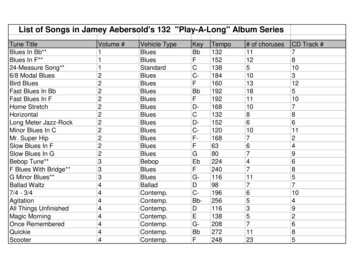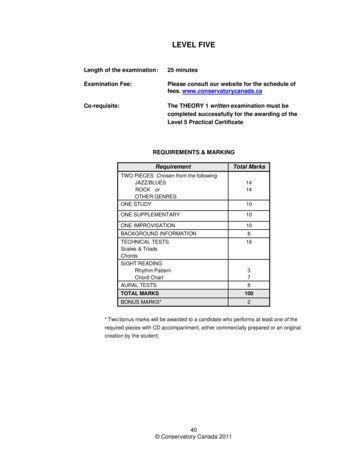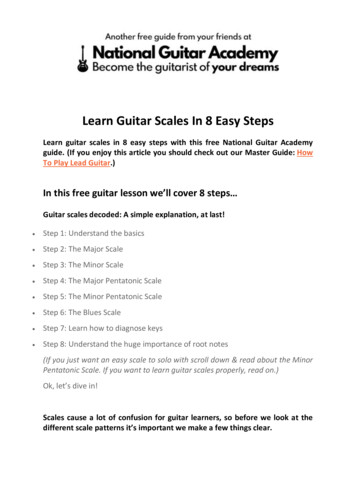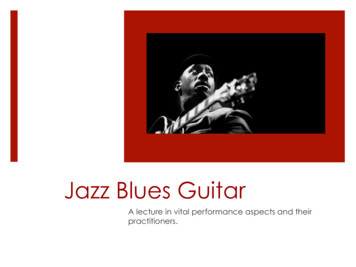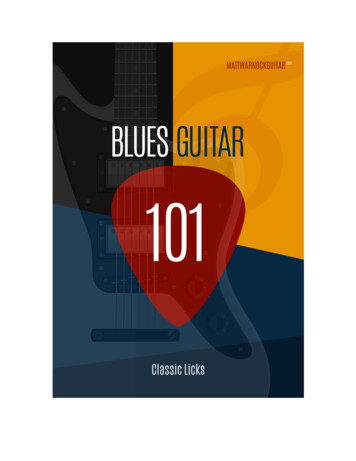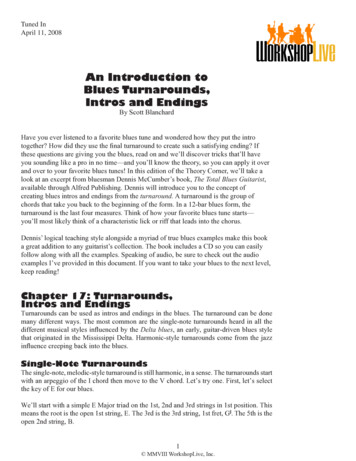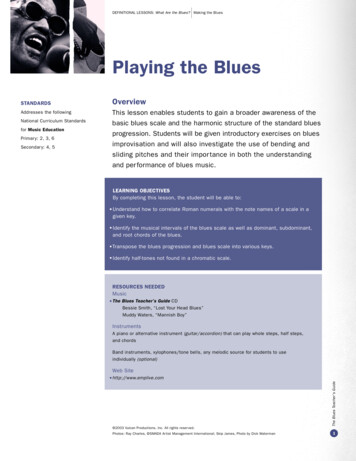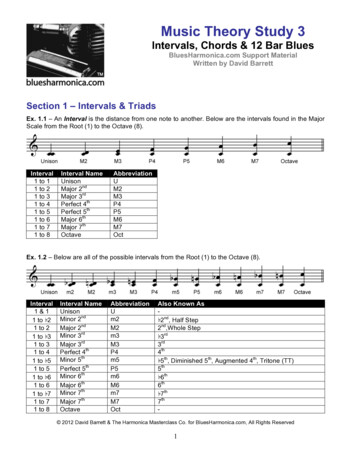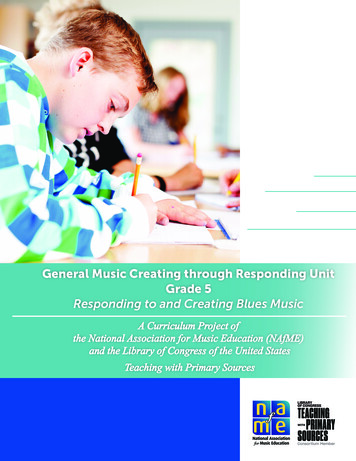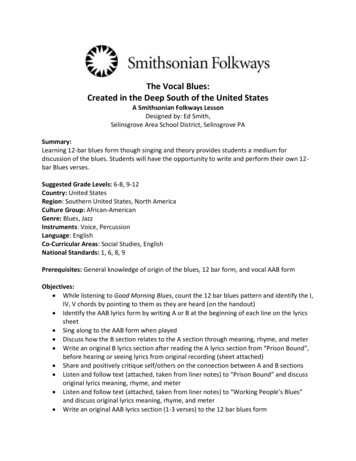
Transcription
The Vocal Blues:Created in the Deep South of the United StatesA Smithsonian Folkways LessonDesigned by: Ed Smith,Selinsgrove Area School District, Selinsgrove PASummary:Learning 12-bar blues form though singing and theory provides students a medium fordiscussion of the blues. Students will have the opportunity to write and perform their own 12bar Blues verses.Suggested Grade Levels: 6-8, 9-12Country: United StatesRegion: Southern United States, North AmericaCulture Group: African-AmericanGenre: Blues, JazzInstruments: Voice, PercussionLanguage: EnglishCo-Curricular Areas: Social Studies, EnglishNational Standards: 1, 6, 8, 9Prerequisites: General knowledge of origin of the blues, 12 bar form, and vocal AAB formObjectives: While listening to Good Morning Blues, count the 12 bar blues pattern and identify the I,IV, V chords by pointing to them as they are heard (on the handout) Identify the AAB lyrics form by writing A or B at the beginning of each line on the lyricssheet Sing along to the AAB form when played Discuss how the B section relates to the A section through meaning, rhyme, and meter Write an original B lyrics section after reading the A lyrics section from “Prison Bound”,before hearing or seeing lyrics from original recording (sheet attached) Share and positively critique self/others on the connection between A and B sections Listen and follow text (attached, taken from liner notes) to “Prison Bound” and discussoriginal lyrics meaning, rhyme, and meter Listen and follow text (attached, taken from liner notes) to “Working People’s Blues”and discuss original lyrics meaning, rhyme, and meter Write an original AAB lyrics section (1-3 verses) to the 12 bar blues form
Sing/speak in tempo at least one verse of their compositionMaterials: “Good Morning Blues” by Lead Belly from Lead Belly Sings for Children (SFW45047 emid 35987 Lyric sheet and Blues chord sheet (attached) Liner notes for lyrics:http://media.smithsonianfolkways.org/liner notes/smithsonian ays.org/liner notes/folkways/FW02471.pdf “Prison Bound” by Memphis Slim from The Folkways Years, 1959-1973 (SFW40128 temID 2677 Liner notes for lyrics:http://media.smithsonianfolkways.org/liner notes/smithsonian folkways/SFW40128.pdf Lyric worksheets (attached, taken from liner notes) “Working People’s Blues” by Barbara Dane from Barbara Dane Sings the Blues(FW02471 emid 8788 Liner notes: http://media.smithsonianfolkways.org/liner notes/folkways/FW02471.pdf Lyric worksheets (attached, taken from liner notes)Lesson Segments:1. 12 Bar Blues Form (National Standards 1, 6, 9)2. Completing a 12 Bar Vocal Blues (National Standards 1, 6, 8, 9)3. Writing an Original 12 Bar Vocal Blues (National Standards 1, 6, 8, 9)1. 12 Bar Blues Forma. Discuss history of blues (use liner notes from Barbara Dane: The Meaning of theBlues, pages 8-10)http://media.smithsonianfolkways.org/liner notes/folkways/FW02471.pdfb. Review 12 bar blues form (attached)c. Play “Good Morning Blues”.i. Have students point to chords/measures as they are heardii. Play again and have students snap fingers on beats 2 & 4d. Review AAB vocal form (line-A, repeated once and then followed by a single lineB conclusion) and read together the lyrics to “Good Morning Blues” (attachedtaken from liner notes).i. Discuss how B section relates to A sections through lyrics meanings,rhyme, metere. Sing along with recording.
12 BAR BLUES FORMIIVVIIVIVVOCAL BLUES FORMIIIIII (V)A sectionA sectionB sectionGood Morning Blues - lyrics taken from liner notes(B section in italic for identification)Well, good morning blues, blues how do you doWell, good morning blues, blues how do you doI'm doing all right well, good morning how are you.I couldn't sleep last night, I was turning from side to sideOh Lord, I was turning from side to sideI wasn't sad, I was just dissatisfied.I couldn't sleep last night, you know the blues walking ‘round my bed,Oh Lord, the blues walking 'round my bedI went to eat my breakfast, the blues was in my bread.Well good morning blues, blues how do you do.Well, good morning blues, blues how do you do.I'm doing all right, well, good morning how are you.Assessment: Students will demonstrate knowledge of form by pointing to measures of music asit is played and identifying I, IV, V chords and the AAB vocal sections. Students will engage inmature discussions on AAB lyrics and how they relate.2. Completing a 12 Bar Vocal Bluesa. Review 12 bar blues and AAB vocal form.b. Hand out A section lyric verses from “Prison Bound” (attached).i. Have students write an original B section that relates/completes Asectionii. Analyze and critique self/others through positive, mature feedbackc. Read actual lyrics from “Prison Bound” and discuss original lyrics meaning,rhyme, and meter.i. Compare/contrast students’ B sections examples with original lyricsd. Sing along with recording.“Prison Bound” worksheet
Write an original B verse to complete A sections givenA - Early One Morning the blues came falling down.A - Early One Morning the blues came falling down.B -A - When they had my trial, Baby you could not be found.A - When they had my trial, Baby you could not be found.B -A - All last night, I sat in my cell alone.A - All last night, I sat in my cell alone.B -A - Baby, you may never see my smiling face again.A - Baby, you may never see my smiling face again.B -A - Sometimes I wonder, why don’t you write to me?A - Sometimes I wonder, why don’t you write to me?B -Prison Bound - lyrics taken from liner notes(B section in italic for identification)Early One Morning the blues came falling down.Early One Morning the blues came falling down.All locked up in jail, now I’m prison bound.When they had my trial, Baby you could not be found.When they had my trial, Baby you could not be found.Too late, mistreatin’ mama, your daddy’s prisoner bound.All last night, I sat in my cell alone.All last night, I sat in my cell alone.I was thinking about you baby, and my happy home.Baby, you may never see my smiling face again.Baby, you may never see my smiling face again.But you must always remember, that I have been your friend.Sometimes I wonder, why don’t you write to me?
Sometimes I wonder, why don’t you write to me?Now I’ve been a bad fellow, I never did intend to be.Assessment: Students will demonstrate knowledge of AAB form by completing original lyrics ofthe B section. Students will participate in mature discussions on lyric meanings, rhyme, meter,and how they relate.3. Writing an Original 12 Bar Vocal Bluesa. Review 12 bar blues and AAB vocal form.b. Read lyrics from “Working People’s Blues” and discuss lyric’s meaning, rhyme,and meter.i. Listen to recording and sing alongc. Students will write original AAB blues lyrics (1-3 verses, worksheet attached).i. Share, analyze and critique self/others through positive, mature feedbackd. Sing/speak with chord progression, at least one verse of each composition.Working People’s Blues – lyrics taken from liner notesWorking people get the blues, from morn till late at night.Working people get the blues, from morn till late at night.It’s a cold-hearted feeling, when there ain’t no end in sight.Forty long hours a week, fifty long weeks a year.Forty long hours a week, fifty long weeks a year.Such a big piece of life, makes me wonder what I’m doing here.I try to hope for the future, see what tomorrow brings.I try to hope for the future, see what tomorrow brings.When I know in my heart, it’s going to be the same old thing.Take your capitol gains, let me deduct the blues.Take your capitol gains, let me deduct the blues.I’ll have more money coming back, then a high rolling daddy can use.Assessment: Students will demonstrate knowledge of Blues and its AAB form by writing originallyrics. Students will participate in mature discussions on lyric meanings, rhyme, meter, and howthey relate.ORIGINAL BLUES WORKSHEET
(Write an original AAB Blues verse)A -A -B -A -A -B -A -A -B -
The Vocal Blues: Created in the Deep South of the United States A Smithsonian Folkways Lesson Designed by: Ed Smith, Selinsgrove Area School District, Selinsgrove PA Summary: Learning 12-bar blues form though singing and
